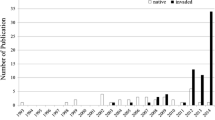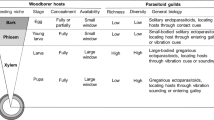Abstract
We review North American research on Compsilura concinnata (Meigen), a highly generalist tachinid parasitoid that was introduced in 1906 to control two invasive forest insects: gypsy moth and browntail moth. The impact on gypsy moth in natural populations in North America has long thought to be minor, a view confirmed by recent work in Canada and Wisconsin, USA. However, research with experimentally created populations of gypsy moth suggests that it may be more important than previously realized. Studies on browntail moth in both naturally occurring and experimental populations suggest that C. concinnata is probably the main reason browntail moth disappeared from most of its former range in North America. Research on giant silk moths suggests that C. concinnata has become the major source of mortality among several species and may be responsible for the notable decline in their densities that has occurred over the last century. C. concinnata has been touted as a premier example of the generalist natural enemy that should be avoided in classical biological control introductions, yet in the case of browntail moth its effect has been extremely beneficial.




Similar content being viewed by others
References
Arnaud PH Jr (1978) A host–parasite catalog of North American Tachinidae (Diptera). Publication No. 1319. USDA Science & Education Administration, Washington, USA
Blair CP (1979) The browntail moth, its caterpillar and their rash. Clin Exp Dermatol 4:215–222
Boettner GH, Elkinton JS, Boettner CJ (2000) Effects of a biological control introduction on three nontarget native species of saturniid moths. Conserv Biol 14:1798–1806
Briese DT (2005) Translating host-specificity test results into the real world: the need to harmonize the yin and yang of current testing procedures. Biol Control 35:208–214
Burgess AF (1923) Controlling the gipsy moth and the brown-tail moth. USDA Farmer’s Bulletin 1335, Washington, USA
Burgess AF, Crossman SS (1929) Imported insect enemies of the gipsy (sic) moth and the brown-tailed moth. USDA Tech Bull No 86, Washington, USA
Campbell RW (1975) The gypsy moth and its natural enemies. Bulletin No. 381. USDA, Washington, USA
Coulson JR, Soper RS, Williams DW (eds) (1991) Biological control quarantine: needs and procedures. In: Proceedings of a workshop sponsored by USDA Agricultural Research Service ARS-99, USA
Culver JJ (1919) A study of Compsilura concinnata, an imported tachinid parasite of the gipsy (sic) moth and the brown-tail moth. Bulletin 766. USDA, Washington, USA
Eliot IM, Soule CG (1902) Caterpillars and their moths. Century Co, Boston, USA
Elkinton JS, Boettner GH (2004) The effects of Compsilura concinnata, an introduced generalist tachinid, on non-target species in North America: a cautionary tale. In van Driesche RG, Murray T (eds) Assessing host ranges of parasitoids and predators used for classical biological control. US Forest Service General Technical Bulletin, pp 4–14
Elkinton JS, Liebhold AM (1990) Population dynamics of gypsy moth in N. America. Annu Rev Entomol 35:571–596
Elkinton JS, Parry D, Boettner GH (2006) Implicating an introduced generalist parasitoid in the invasive browntail moth’s enigmatic decline. Ecology 87:2664–2672
Ferguson CS, Elkinton JS, Gould JR, Wallner WE (1994) Population regulation of gypsy moth (Lepidoptera: Lymantriidae) by parasitoids: does spatial density dependence lead to temporal density dependence? Environ Entomol 23:1155–1164
Fernald CH, Kirkland AH (1903) The brown tailed moth, Euproctis chrysorrhoea: a report on the life history and habits of the imported brown-tail moth, etc. Wright and Potter, Boston, USA
Forbush EH, Fernald CH (1896) The gypsy moth. Wright and Potter Printing Co, Boston, USA
Godfray HCJ (1995) Field experiments with genetically manipulated insect viruses: ecological issues. TREE 10:465–469
Gould JR, Elkinton JS, Wallner WE (1990) Density-dependent suppression of experimentally created gypsy moth, Lymantria dispar (Lepidoptera: Lymantriidae), populations by natural enemies. J Anim Ecol 59:213–233
Gray RH, Lorimer CG, Tobin PC, Raffa KF (2008) Preoutbreak dynamics of a recently established invasive herbivore: roles of natural enemies and habitat structure in stage-specific performance of gypsy moth (Lepidoptera: Lymantriidae) populations in northwestern Wisconsin. Environ Entomol 37(5):1174–1184
Hajek AE (2007) Classical biological control of gypsy moth: Introduction of the entomopathogenic fungus Entomophaga maimaiga into North America. In: Vincent C, Goettel M, Lazarovits G (eds) Biological control: international case studies. CABI Publications, Wallingford, UK, pp 53–62
Hajek AE, Tobin PC (2011) Introduced pathogens follow the invasion front of a spreading alien host. J Anim Ecol 80:1217–1226
Henneman ML, Memmott J (2001) Infiltration of a Hawaiian community by introduced biological control agents. Science 293:1314–1316
Hoddle MS (2004) Restoring balance: using exotic species to control invasive exotic species. Conserv Biol 18(1):38–49
Howard LO, Fiske WF (1911) The importation into the United States of the parasites of the gipsy-moth and the browntail moth. USDA Bureau of Entomology Bulletin No. 1
Howarth FG (1991) Environmental impacts of classical biological control. Annu Rev Entomol 36:485–509
Kellogg SK, Fink LS, Brower LP (2003) Parasitism of native luna moths, Actias luna (L.) (Lepidoptera:Saturniidae) by the introduced Compsilura concinnata (Meigen) (Diptera: Tachinidae) in central Virginia, and their hyperparasitism by trigonalid wasps (Hymenoptera: Trigonalidae). Environ Entomol 32:1019–1027
Lynch LD, Thomas MB (2000) Nontarget effects in the biological control of insects with insects, nematodes and microbial agents: the evidence. Biocontrol News Inf 21:117–130
Marsh FL (1935) A regional study of Samia cecropia and nine associated primary parasites and hyperparasites: presenting data on the behavior, biology, and interrelationships of these insects. Thesis, Northwestern University, Evanston, USA
Marsh FL (1937) Ecological observations upon the enemies of Cecropia, with particular reference to its hymenopterous parasites. Ecology 18:106–112
Obrycki JJ, Elliott NC, Giles KL (2000) Coccinellid introductions: potential for and evaluation of nontarget effects. In: Follet PA, Duan JJ (eds) Nontarget effects of biological control. Kluwer, Dordrecht, The Netherlands, pp 127–145
Parry D (2009) Beyond Pandora’s box: quantitatively evaluating non-target effects of parasitoids in classical biological control. Biol Invasions 11:47–58
Reardon RC (1976) Parasite incidence and ecological relationships in field populations of gypsy moth larvae and pupae. Environ Entomol 5:981–987
Sanchez V (1996) The genetic structure of northeastern populations of the tachinid Compsilura concinnata (Meigen), an introduced parasitoid of exotic forest defoliators of North America. Thesis, University of Massachusetts Amherst, USA
Schaefer PW (1974) Population ecology of the browntail moth, Euproctis chrysorrhoea (Lepidoptera: Lymantriidae). Dissertation University of Maine, Orono, USA
Schaffner JV, Griswold CL (1934). Macrolepidoptera and their parasites reared from field collections in the northeastern part of the United States. Publication No. 188. USDA, Washington, USA
Schweitzer DF (1988) Status of Saturniidae in the northeastern USA: a quick review. News Lepidopterist Soc 1:4–5
Selfridge JA, Parry D, Boettner GH (2007) Parasitism of barrens buck moth Hemileuca maia Drury in early and late successional pine barrens habitats. J Lepid Soc 61(4):213–221
Sisojevic P (1975) Population dynamics of tachinid parasites of the gypsy moth (Lymantria dispar L.) during a gradation period (in Serbo-Croatian). Zasitia Bilja 132:97–170
Smith JB (1908) Notes on some Cecropia cocoons and parasites. J Econ Entomol 1:293–297
Stamp NE, Bowers MD (1990) Parasitism of New England buckmoth caterpillars (Hemileuca lucina: Saturniidae) by tachinid flies. J Lepid Soc 44:199–200
Strazanac JS, Plaugher CD, Petrice TR, Butler L (2001) New tachinidae (Diptera) host records of eastern North American forest canopy Lepidoptera: baseline data in a Bacillus thuriengiensis variety kurstaki nontarget study. J Econ Entomol 94:1128–1134
Timms LL (2010) What happens after establishment? The indirect impacts of the gypsy moth on native forest caterpillar communities. PhD thesis, University of Toronto, Canada
Timms LL, Smith SM (2011) Effects of gypsy moth establishment and dominance in native caterpillar communities of northern oak forests. Can Entomol 143:479–503
Tuskes PM, Tuttle JP, Collins MM (1996) The wild silk moths of North America: a natural history of the Saturniidae of the United States and Canada. Cornell University Press, Ithaca, USA
van Driesche RG, Hoddle M (1997) Should arthropod parasitoids and predators be subject to host range testing when used as biological control agents? Agric Hum Values 14:211–226
Wagner DL, van Driesche RG (2010) Threats posed to rare or endangered insects by invasions of nonnative species. Annu Rev Entomol 55:547–568
Wapshere AJ (1989) A testing sequence for reducing rejection of potential biological control agents for weeds. Ann Appl Biol 114:515–526
Webber RT, Schaffner JV Jr (1926) Host relations of Compsilura concinnata Meigen, an important tachinid parasite of the gipsy moth and the brown-tail moth. Bulletin No. 1363. USDA, Washington
Wilkinson TK, Landis DA, Gut LJ (2004) Parasitism of obliquebanded leafroller (Lepidoptera: Tortricidae) in commercially managed Michigan apple orchards. J Econ Entomol 97:1524–1530
Williams DW, Fuester RW, Metterhouse WW, Balaam RJ, Bullock RH, Chianese RJ, Reardon RC (1992) Incidence and ecological relationships of parasitism in larval populations of Lymantria dispar (Lepidoptera: Lymantriadae). Biol Control 2:35–43
Wold-Burkness SJ, Hutchison WD, Bolin PC, Heimpel GE (2005) A long-term survey of parasitoid species composition and parasitism of Trichoplusia ni (Lepidoptera: Noctuidae), Plutella xylostella (Lepidoptera: Plutellidae), and Pieris rapae (Lepidoptera: Pieridae) in Minnesota cabbage. J Entomol Sci 40:211–221
Acknowledgments
This research was supported by a cooperative agreement no. 42-95-0015 from the Northeastern Forest Experiment Station, USDA Forest Service and grant No. DEB0089699 from the National Science Foundation. We thank the many student and non-student employees who have helped with our field research. We thank Roy van Driesche and two anonymous reviewers for suggestions and comments on this manuscript.
Author information
Authors and Affiliations
Corresponding author
Additional information
Handling Editor: Kevin Heinz
Rights and permissions
About this article
Cite this article
Elkinton, J.S., Boettner, G.H. Benefits and harm caused by the introduced generalist tachinid, Compsilura concinnata, in North America. BioControl 57, 277–288 (2012). https://doi.org/10.1007/s10526-011-9437-8
Received:
Accepted:
Published:
Issue Date:
DOI: https://doi.org/10.1007/s10526-011-9437-8




